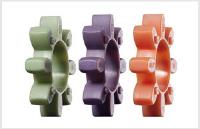 Add My Company
Add My Company
Sign In
How to select a jaw-type coupling
23-04-2018

As a manufacturer of flexible couplings, KTR would like to share with you some basics regarding the selection of our ROTEX jaw-type couplings.
But first things first, what exactly is a jaw-type coupling? Jaw-type couplings are often used to transmit torque by connecting two shafts for the purpose of power transmission. A standard jaw coupling consists of two metallic hubs and a “spider” element that provides protection from harmful vibrations. The material of spider elements can vary in hardness to accommodate different applications. The harder spiders increase torsional strength of the coupling while decreasing its ability to absorb unwanted (and sometimes harmful) vibrations. Selecting the proper spider element for your system will ensure the coupling suffers the wear and tear of your system.
Furthermore, one of the principal duties of a coupling is to act as a fuse in the drive train, transmitting power up to a, hopefully, predetermined point of failure, vitally ensuring the protection of more expensive components.
With this in mind, it’s important to note that jaw-type couplings are considered fail-safe. This means that it will continue to transmit power regardless of whether the spider element fails, due to the interlocking jaws of opposing hubs. Depending on the application, this may or may not be a desirable characteristic. For instance, in most cases a coupling design is selected to fail completely in max overload situations, acting as a fuse in the system and protecting more expensive components such as motors and gearboxes. However, in the case of fire fighting pumps, it’s critical that the pumps keep running, therefore a coupling with interlocking metal jaws is required in order to ensure power transmission continues even after the failure of an element.
While there are many different hub variations of jaw-type couplings, the following components will help you select the best one for your system.
Torque
One of the most important criteria to consider when selecting jaw-type couplings is the level of torque it will be required to handle. To determine this multiply the power involved (kW) by a constant of 9550 and divide by speed (rpm).
A coupling’s torque range is primarily determined by hub material and size, but it can be increased by inserting stronger, more rigid elements. Utilizing a more rigid element increases the torsional stiffness of the entire coupling and heightens its ability to transmit power. The most rigid couplings are referred to as backlash-free couplings. These are generally used with servo drives and applications demanding high positional control. Although this can be advantageous, the disadvantage is that couplings with more rigid elements have a reduced ability to mitigate torsional vibration and manage misalignments.
A good rule of thumb to remember is that backlash-free jaw couplings work well for precision stop-and-start movements, while standard jaw couplings are better equipped to deal with vibration and misalignment.
For more information on How to select a jaw-type coupling talk to KTR U.K. Ltd
Enquire Now
List your company on FindTheNeedle.

